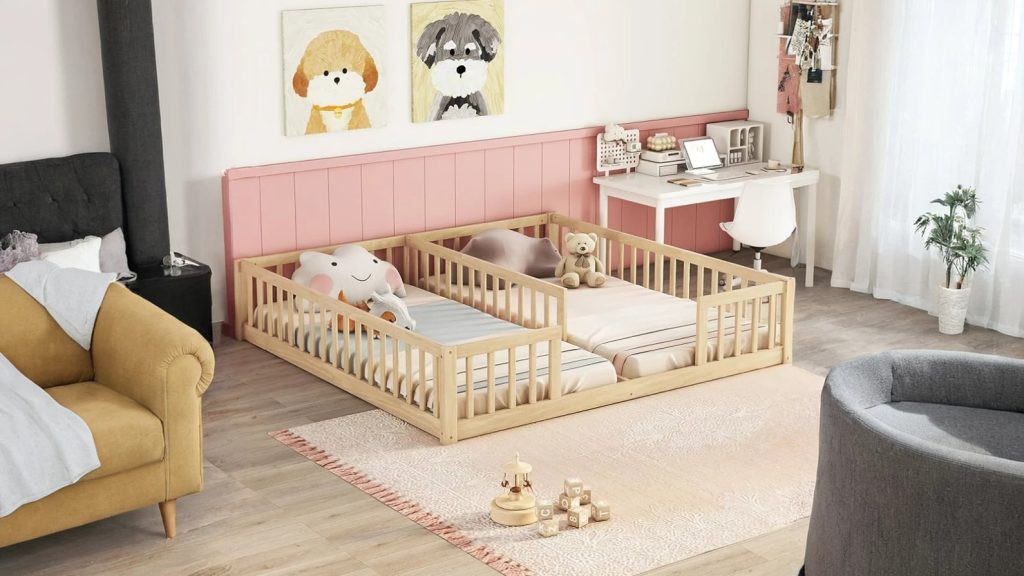As parents, caregivers, or guardians, we’re constantly searching for that sweet spot between safety, comfort, and functionality when it comes to our children’s bedrooms. The transition from a crib or toddler bed to a “big kid bed” can feel equal parts exciting and nerve-racking. You want your child to have independence, but you also want peace of mind that they’ll be safe at night. Enter the twin floor bed—a bedroom solution that has quietly gained popularity among families seeking a balance of practicality, affordability, and child-first design.
Twin floor beds are exactly what they sound like: twin-sized mattresses placed close to the floor, often accompanied by sleek frames that support and define the bed while minimizing height. Inspired by Montessori principles, they encourage independence, safety, and even creativity in a child’s environment.
This guide will dive deep into why twin floor beds have become a hit with modern families, the benefits they offer, how to choose the right one, style and décor tips, safety considerations, and answers to common parent questions. By the end, you’ll be well-equipped to decide if a twin floor bed is the right fit for your growing child.
What Is a Twin Floor Bed and Why Is It Popular?
A twin floor bed is simply a twin mattress placed at or near floor level, sometimes with a supportive frame, and sometimes just the mattress itself. Unlike traditional elevated beds, these reduce the risk of falls while encouraging freedom of movement.
Key Reasons for Its Popularity:
- Safety: Low profile prevents injuries from rolling out of bed.
- Montessori Influence: Builds independence and autonomy.
- Affordability: Less expensive than bulky traditional furniture.
- Flexibility: Works for toddlers, school-aged kids, or even minimalistic adult setups.
- Aesthetic Appeal: Available in sleek wooden frames, house-shaped frames, or playful themed designs.
What Are the Benefits of a Twin Floor Bed for Kids?
1. Safety and Peace of Mind
Parents rest easier knowing their child is sleeping close to the floor. Rolling out of bed is no longer a “bone-rattling thud” moment—it’s usually just a gentle flop onto a rug.
2. Encourages Independence
Children can climb in and out of bed by themselves, learning responsibility and confidence with bedtime routines.
3. Supports Development
Aligned with Montessori philosophy, it empowers kids to explore their rooms freely rather than being restricted by bed rails.
4. Space-Saving and Flexible Design
Twin floor beds often omit bulky headboards or high platforms, keeping rooms open and airy. Ideal for small spaces or shared bedrooms.
5. Easy Transition from Crib to Bed
Instead of leaping to a full “big bed” setup, a twin floor bed acts as a comfortable middle step.
How Do You Choose the Right Twin Floor Bed?
Selecting the perfect twin floor bed involves blending safety, durability, and style. Here’s a step-by-step guide:
- Measure Your Space: Twin beds are 38″ x 75″. Ensure enough floor clearance for play and furniture.
- Check Frame Style Options:
- Classic Wood Frames: Sturdy, timeless.
- House-Shaped Frames: Fun and whimsical for kids.
- Minimal Frames: Sleek and modern.
- Verify Material Quality: Solid wood or non-toxic finishes = safer, longer-lasting.
- Budget Consideration: Twin floor beds start around $90 and can go past $400 depending on design.
- Ease of Assembly: Some are nearly plug-and-play, while others require minor handyman skills.
- Mattress Type: Opt for breathable, medium-firm mattresses with washable covers.
Are Twin Floor Beds Really Safe?
Yes, with a few precautions. While the bed itself is designed for safety, parents can enhance this by:
- Placing a soft area rug under and around the bed.
- Ensuring no sharp-edged furniture is nearby.
- Double-checking frame edges for smooth finishes.
- Teaching children to keep the bed area toy-free during sleep.
Think of it this way: a twin floor bed is less “fall risk” and more “gentle roll to freedom.”
How to Style and Decorate a Twin Floor Bed
This is where fun meets functionality! A twin floor bed doubles as an anchor for room design.
Styling Ideas:
- House Frame Bed: String fairy lights across the roof for a magical touch.
- Minimalist Setup: Crisp neutral bedding + layered textures to keep things cozy.
- Adventure Theme: Canopies, tent-style designs, or jungle prints for imaginative play.
- Sibling Harmony: Matching twin floor beds side by side for a charming shared-room vibe.
Pro Tip: Opt for washable, hypoallergenic bedding because children and mystery spills are a combo that keeps parents humble.
Twin Floor Bed vs. Traditional Bed: Which Is Better?
| Feature | Twin Floor Bed | Traditional Twin Bed |
|---|---|---|
| Height | Near floor level, minimal fall risk | Elevated, requires rails for young kids |
| Montessori-Friendly | Yes, encourages independence | Less so, often restrictive |
| Cost Range | Affordable, varies by design | Usually more expensive |
| Style Options | Modern/minimalist/house designs | Classic bedframes + headboards |
| Best Age Range | Toddlers to tweens | Older kids, teens, adults |
Verdict: For toddlers and younger children, a twin floor bed usually wins for safety and independence.
Practical Tips for Transitioning Your Child to a Twin Floor Bed
- Involve Your Child: Let them choose bedding colors or a fun pillow. Ownership encourages enthusiasm.
- Keep Routine Consistent: Maintain existing bedtime rituals (stories, lullabies, hugs).
- Create a Safe Environment: Child-proof outlets, cords, and reachable drawers before introducing the bed.
- Be Patient: It can take a couple of weeks for children to fully adjust.
FAQs About Twin Floor Beds
Q1: What age is best for a twin floor bed?
A: Generally between 18 months and 3 years when children start climbing out of the crib. But it’s flexible, and older kids can enjoy them too.
Q2: Can older kids (8–12) use a twin floor bed?
A: Yes, absolutely! At that stage, it may simply become more about personal design style rather than safety.
Q3: Are frames necessary for twin floor beds?
A: Not always. Some parents go completely frameless with the mattress on the floor, but frames add structure, air circulation, and aesthetics.
Q4: Do twin floor beds affect mattress lifespan?
A: They can, especially if airflow is restricted. Choosing slatted or raised base designs helps extend mattress life.
Q5: How do I keep the bedding tidy when it’s so low?
A: Use fitted sheets and consider zippered bedding systems designed to make bed-making less of a yoga workout.
Q6: Are floor beds harder to clean around?
A: Slightly, but keeping a slim vacuum attachment nearby usually solves the problem.
Conclusion
The twin floor bed is far more than a trendy parenting hack—it’s a thoughtful solution that balances safety, independence, and style for growing children. Whether you’re making the leap from crib to first “big kid bed,” or just looking for a practical, space-saving upgrade, this option checks every box. From promoting confidence to reducing bedtime stress, it’s no wonder families are welcoming floor beds into their homes.
Now that you know the benefits, buying tips, and styling tricks, you can choose a twin floor bed that perfectly suits your child’s stage and personality. Share this guide with other parents, drop your own experiences in the comments, and encourage sweet dreams all around.

